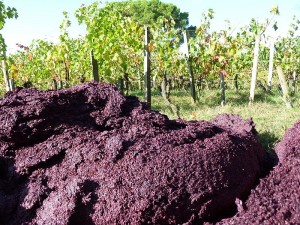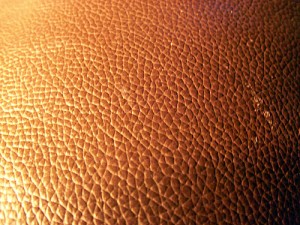I’ve covered the topic of the recycling of wine industry a lot lately on The Academic Wino, as it is it becoming increasing more desired in the wine business to not only decrease the contaminants and potentially toxic chemicals in the environment, but to also increase the overall sustainability of the industry as a whole. Everywhere I look there are more and more papers on the topic, and even though they vary widely in their potential applications, they all boil down to the same thing: environmental friendliness and sustainable practices. In the European Union, there is approximately 14.5 million tons of wine industry

Photo by davity dave: http://upload.wikimedia.org/wikipedia/commons/thumb/3/33/Pomace_in_the_vineyard_after_pressing.jpg/800px-Pomace_in_the_vineyard_after_pressing.jpg
waste produced from wineries within its borders, which is a lot of material that could be recycled and reused for other purposes.
Most of you are aware by now that wine industry waste contains primarily crushed grape skins, seeds, and pulp. You also may know already that these winemaking by-products are rich in beneficial polyphenol compounds that act as antioxidants, antibacterial agents, anticarcinogenic agents, antiviral agents, et cetera. We’ve seen research that focuses on using wine industry wastes as supplements to one’s diet; for use as supplements to the winemaking process in order to improve wine quality; for adding to processed meats to reduce carcinogenic properties; and for coming with animal manure to produce an alternative fuel source, just to name a few.
Today’s paper focuses on yet another application for wine industry waste: as a treatment in leather production to reduce toxic by-products often associated with the process. Now, I understand that leather production in and of itself is a hot topic amongst many animal rights proponents, however, I’ll ask you to bear with me and not go down that road for now. I am not taking any stance in this post on the use of leather for the purpose of clothing or other products, however, since this is a common practice around the world, it is important to find more “environmentally and health friendly” ways to produce it, regardless of whether or not you agree to the practice to begin with. That issue is a whole other discussion which is not appropriate for this type of blog.
Back to the topic at hand…
One of the by-products of leather production is formaldehyde, which at certain levels can be very unpleasant to the nostrils, as well as toxic to both humans and the environments. Something that is used in preserving dead creatures for

Photo source: http://upload.wikimedia.org/wikipedia/commons/thumb/5/57/Formaldehyde-2D.svg/634px-Formaldehyde-2D.svg.png
science labs isn’t exactly something I would want to be in contact with for extended periods of time. Formaldehyde is not actually used in the production of leather; however, compounds in the leather itself can react with other production agents (i.e. synthetic tanning agents, resins, etc) and produce free formaldehyde in the air around it. This free formaldehyde can cause an array of health problems, and is known to illicit allergic responses in some individuals.
Many countries throughout the world have placed limits on the allowable levels of formaldehyde. The European Union classifies formaldehyde as a Category 3 suspected carcinogen, with allowable levels of formaldehyde in clothes which are not in direct contact with the skin no greater than 300ppm (parts per million). Levels of formaldehyde in clothes which are not in direct contact with the skin are very similar in New Zealand, and are even lower for children and those with sensitive skin. Allowable levels of formaldehyde in the United States vary depending upon the context. For example, OSHA (Occupational Safety and Health Administration) permissible exposure limits in air are 0.75ppm, short term exposure limits (over 15 minutes) are 2ppm, and action levels (over an 8 hour period) are 0.5ppm. It is in the best interest of those working in the leather production industry, and ultimately those that are exposed to the leather once it is finished, that ways to reduce free formaldehyde in the air is of critical importance.
In a previous study performed by the authors of the current study, they found that by using Camellia sinensis and Vinca rosea, the leaves and flowers of which are utilized to make tea and therapeutic compounds, respectively, were effective in reducing the levels of free formaldehyde in leather production. The common compounds between the two, which were likely involved in the reduction of formaldehyde levels were the tannins; as well as the polyphenolic compound catechin (part of the flavanol family) and gallic acid components.
Building upon these findings, the authors then examined grape seed extracts, which were produced from wine industry waste. Grape seeds contain many of the same polyphenolic compounds as the species studied previously, and also include proanthocyanidin molecules which are also part of the flavanol family. Would grape seeds also act to decrease levels of free formaldehyde in leather production as tea had? The paper presented today aimed to examine that very question.
Methods
Vitis vinifera wine grape seeds were utilized in this study, and did not include other portions of the industry waste (such as skins or pulp). Seeds were ground and then prepared by three different methods: 1) as a powder; 2) as an extract; and 3) as an extract using a modified procedure (details omitted by cited in an unpublished document).
The source of the leather was domestic wet salted sheep skins.
Leather was produced using approved methods and was treated with each of the three grape seed treatments plus a non-grape seed control.
Experiments were repeated 3 times.
Results
- Modified grape seed extract treatment resulted in leather with the lowest levels of free formaldehyde.
- All three grape seed treatments (powder, plus two different extracts) reduced the levels of free formaldehyde compared to the control.
- Even though the grape seed powder was effective, it did not completely dissolve in water.
- This created powder residues on the leather which is likely visually unappealing to consumers.
- Extracts did completely dissolve in water, thereby would be more desirable in leather production than the powder.
Concluding Thoughts
This was a short and sweet study, which tested the effectiveness of grape seed powder and extracts on the levels of free formaldehyde in leather production. According to the results, all treatments made from grape seeds were effective in reducing the levels of free formaldehyde in leather production, though modified grape seed extracts were the most effective. Even though grape seed powder was effective in reducing the levels of formaldehyde, it is not an ideal product to use in leather production, since the powder did not fully dissolve in water and thereby left a powdery residue on the finished leathers’ surface.
In their concluding statements, the authors suggested that the amount of grape seed extract used in leather production could be increased or decreased in order to further control the levels of free formaldehyde by-products. Specifically,
increasing the amount of grape seed extract in the leather production should further decrease the levels of free formaldehyde produced. This statement was not supplemented with experimental evidence, thus must be taken with a grain of salt. In theory, the prediction is plausible; however, one should not be so confident that it is correct without experimental evidence. This would make a good follow-up experiment to the experiment presented above.
I would be curious to see how extracts made from complete grape marc (i.e. seeds, skins, and pulp) performed in the same experiment. This may be a more realistic approach, as the seeds would not have to be separated from the marc prior to creating the extracts.
Another follow-up experiment could involve different types of leather. Are these extracts as effective with other types of leather? Could these extracts be utilized in the production of synthetic leathers somehow?
In general, this study provided yet another interesting use of wine industry wastes, though certainly more work needs to be done to further optimize the process.
What do you all think of this study or this topic in general? Please feel free to leave your comments!
Sources:
Bayramoğlu, E.E. 2013. Hidden treasure of nature: PAs. The effects of grape seeds on free formaldehyde of leather. Industrial Crops and Products 41: 53-56.
“Proposed Government Product Safety Policy Statement on Acceptable Limits of Formaldehyde in Clothing and Other Textiles”. Ministry of Consumer Affairs, New Zealand. http://www.consumeraffairs.govt.nz/pdf-library/publications/Acceptable-Limits-of-Formaldehyde-in-Clothing-and-Other-Textiles.pdf Accessed 11/10/12.
“OSHA Fact Sheet: Formaldehyde”. Occupational Safety and Health Administration, United States. http://www.osha.gov/OshDoc/data_General_Facts/formaldehyde-factsheet.pdf Accessed 11/10/12.

